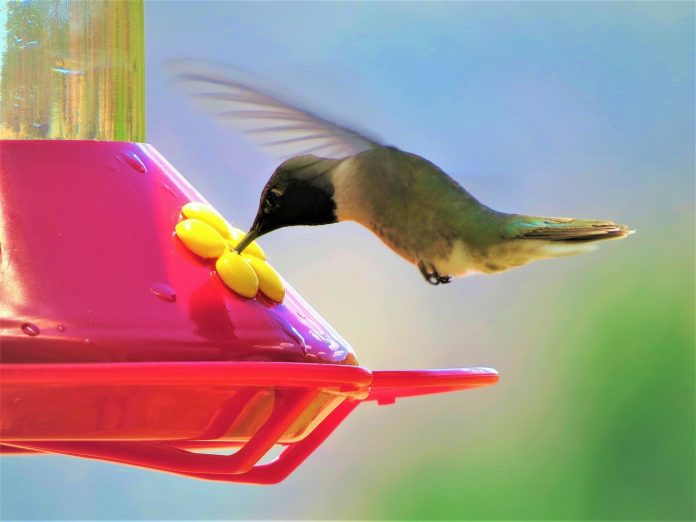As is often the case, hummingbirds have me perplexed this year. A female returned to my feeders May 3.
Throughout the remainder of May, I saw a single hummer just four or five times. I feared it would be a dismal year for hummers here on the ridge.
Return
Suddenly about two weeks ago, hummers began visiting my feeders regularly. First individual birds arrived to sip nectar.
After a few days, several would compete for space at the feeders. Numbers were still lower than the best of years, but my fears for a terrible year eased.
When hummers were not actually feeding, they constantly harassed each other. I still haven’t seen more than three at a time, but their regular visits give me hope for a good year.
Normally hummers return in late April or early May. Males arrive first and set up territories; females follow several days later.
Breeding
After a few days’ rest, breeding behavior commences. Males display for females by flying in large U-shaped arcs.
Before mating, females often “dance” with a male by flying face to face and mirroring each other’s movements.
The burden of family life lies completely with the female. She builds a tiny nest on a small horizontal branch five to 20 feet above a stream or other open spot. Often the nest is positioned beneath a large leaf that can offer protection from summer rains.
The female begins by using sticky spider silk to fasten bits of leaves or bud scales to the branch. Over the next 10 days, she builds an elastic cup about the size of a walnut.
She lines the nest with soft plant fibers and camouflages the outside with bits of lichen. From the ground, the nest now passes for an inconspicuous knot.
After laying two tiny eggs, she incubates them for about 16 days. This is an incredibly long incubation period for a bird that weighs less than a nickel.
But because the female tends her nest alone, she must leave it periodically to eat. Each time she leaves the nest, the eggs cool a bit.
The price of single parenthood is an extended incubation period. Young hummingbirds leave the nest about three weeks after hatching.
Predators
If they survive climbing snakes, squirrels, chipmunks, and deer mice while in the nest, juvenile hummingbirds face a dizzying array of dangers. Sharp-shinned hawks may snatch them from midair as they learn to fly. They can become ensnared in spider webs.
If they hover too close to the water’s edge, bullfrogs can swallow them whole. And even in a bed of nectar-bearing flowers, they might be ambushed by a praying mantis.
I wondered what could have caused the variation in numbers in May and June. Could it have been the very wet spring we have had this year?
My curiosity triggered a memory of a conversation I had a few years ago with the late, great Alabama-based hummingbird bander, Bob Sargent.
I explained the erratic nature of the hummers’ return that year and mentioned that it had also been a wet spring. Bob explained, “It’s fairly common to have a rush of hummers at feeders after a heavy rain. Insect movement is greatly reduced, and nectar often drips out of flowers if the blossom droops downward.”
In three or four weeks I’ll watch for newly fledged hummers visiting the feeders. Bob reminded me that young ruby-throated hummingbirds lack the adult male’s bright red throat, and that, “newly fledged hummers have pristine white tips on at least their outer three tail feathers. And both sexes, when fledged, have buffy feather edging on the back of the head and down the nape of the neck.”
Nectar
It’s not too late to put up a nectar feeder for hummers because feeder activity will peak from mid-July through early September.
Homemade nectar is easy to make. Just add one part table sugar to four parts boiling water. Stir, cool to room temperature and store in the refrigerator.
Do not use red dye. The red parts of feeders attract hummers’ attention. And never sweeten with honey, which can promote a fungal disease that can kill hummers.













